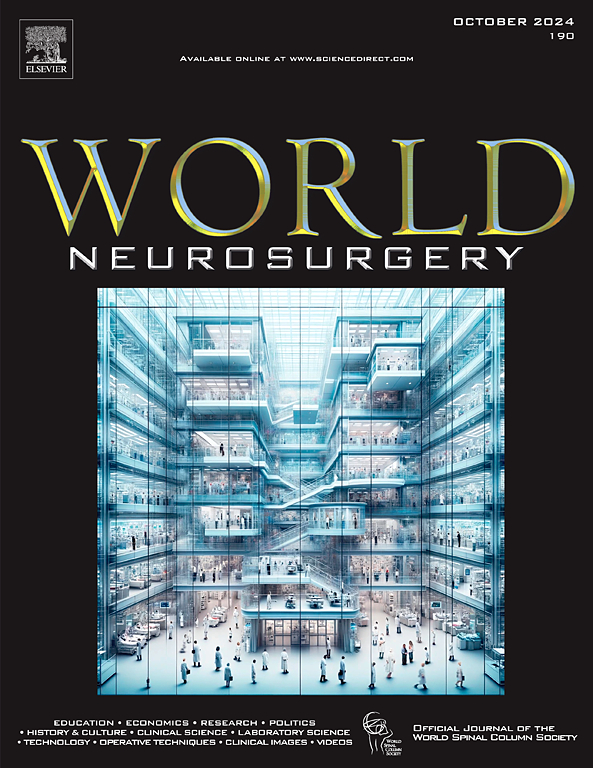Endoport-Assisted Endoscopic Technique for Evacuating Severe Intraventricular Hemorrhage with Cast Third Ventricle Hematoma in an Underwater Field: A Technical Note
IF 1.9
4区 医学
Q3 CLINICAL NEUROLOGY
引用次数: 0
Abstract
Objective
We describe a 2-stage strategy utilizing the endoport-assisted endoscopic technique for the evacuation of severe intraventricular hemorrhage (IVH) with a cast third ventricle, and discuss potential pitfalls in the implementation of this method in clinical practice.
Methods
Patients with severe IVH (Graeb score >6) and a cast third ventricle who presented to our center from 2021 to 2023 were treated with a 2-stage surgical strategy utilizing the endoport-assisted endoscopic technique.
Results
A total of 9 patients with mean age of 55 years were included in the study. The preoperative mean Graeb score was 9, and postoperative mean Graeb score was 3, with a 72% evacuation rate for the entire ventricles. The median duration for external ventricular drainage was observed to be 6 days. In terms of 90-day modified Rankin Scale (mRS) scores, a favorable outcome (mRS 1–3) was demonstrated in 78% of the patients, while the remaining 22% presented with a poor outcome (mRS 4–6). There were no complications related to the surgery itself in any of the reported cases.
Conclusions
The endoport-assisted 2-stage endoscopic technique marks a significant advancement in treating severe IVH with a cast third ventricle. By combining dry and underwater approaches, it provides an innovative solution for effectively and safely clearing hematomas in both lateral and third ventricles. This technique addresses the crucial need for early cerebrospinal fluid circulation restoration, potentially improving outcomes for patients with these complex cases.
在水下抽吸伴有铸型第三脑室血肿的严重脑室内出血的内窥镜辅助技术:技术说明。
目的:作者描述了一种利用内镜辅助技术分两步清除伴有铸型第三脑室的重度脑室内出血(IVH)的策略,并讨论了该方法在临床实践中的潜在缺陷:方法:对2021年至2023年期间在本中心就诊的重度IVH(Graeb评分>6分)且第三脑室有铸型的患者采用内镜辅助下的两阶段手术策略进行治疗:研究共纳入9名患者,平均年龄55岁。术前平均格拉布评分为9分,术后平均格拉布评分为3分,整个心室的排空率为72%。据观察,EVD 引流的中位持续时间为 6 天。从90天的改良Rankin量表(mRS)评分来看,78%的患者预后良好(mRS 1-3),其余22%的患者预后较差(mRS 4-6)。所有报告病例均未出现与手术本身相关的并发症:结论:内镜辅助下的两阶段内镜技术标志着在治疗有铸型第三脑室的重度 IVH 方面取得了重大进展。通过结合干法和水下法,它为有效、安全地清除侧脑室和第三脑室血肿提供了一种创新解决方案。这项技术满足了早期恢复脑脊液循环的关键需求,有可能改善这些复杂病例患者的预后。
本文章由计算机程序翻译,如有差异,请以英文原文为准。
求助全文
约1分钟内获得全文
求助全文
来源期刊

World neurosurgery
CLINICAL NEUROLOGY-SURGERY
CiteScore
3.90
自引率
15.00%
发文量
1765
审稿时长
47 days
期刊介绍:
World Neurosurgery has an open access mirror journal World Neurosurgery: X, sharing the same aims and scope, editorial team, submission system and rigorous peer review.
The journal''s mission is to:
-To provide a first-class international forum and a 2-way conduit for dialogue that is relevant to neurosurgeons and providers who care for neurosurgery patients. The categories of the exchanged information include clinical and basic science, as well as global information that provide social, political, educational, economic, cultural or societal insights and knowledge that are of significance and relevance to worldwide neurosurgery patient care.
-To act as a primary intellectual catalyst for the stimulation of creativity, the creation of new knowledge, and the enhancement of quality neurosurgical care worldwide.
-To provide a forum for communication that enriches the lives of all neurosurgeons and their colleagues; and, in so doing, enriches the lives of their patients.
Topics to be addressed in World Neurosurgery include: EDUCATION, ECONOMICS, RESEARCH, POLITICS, HISTORY, CULTURE, CLINICAL SCIENCE, LABORATORY SCIENCE, TECHNOLOGY, OPERATIVE TECHNIQUES, CLINICAL IMAGES, VIDEOS
 求助内容:
求助内容: 应助结果提醒方式:
应助结果提醒方式:


